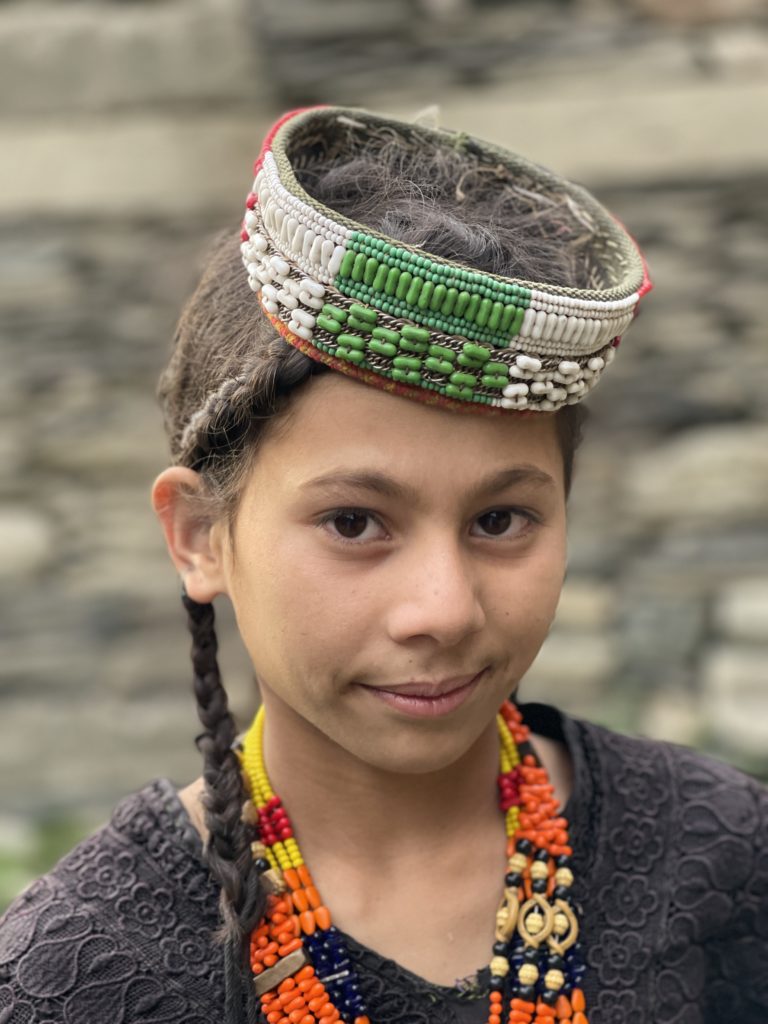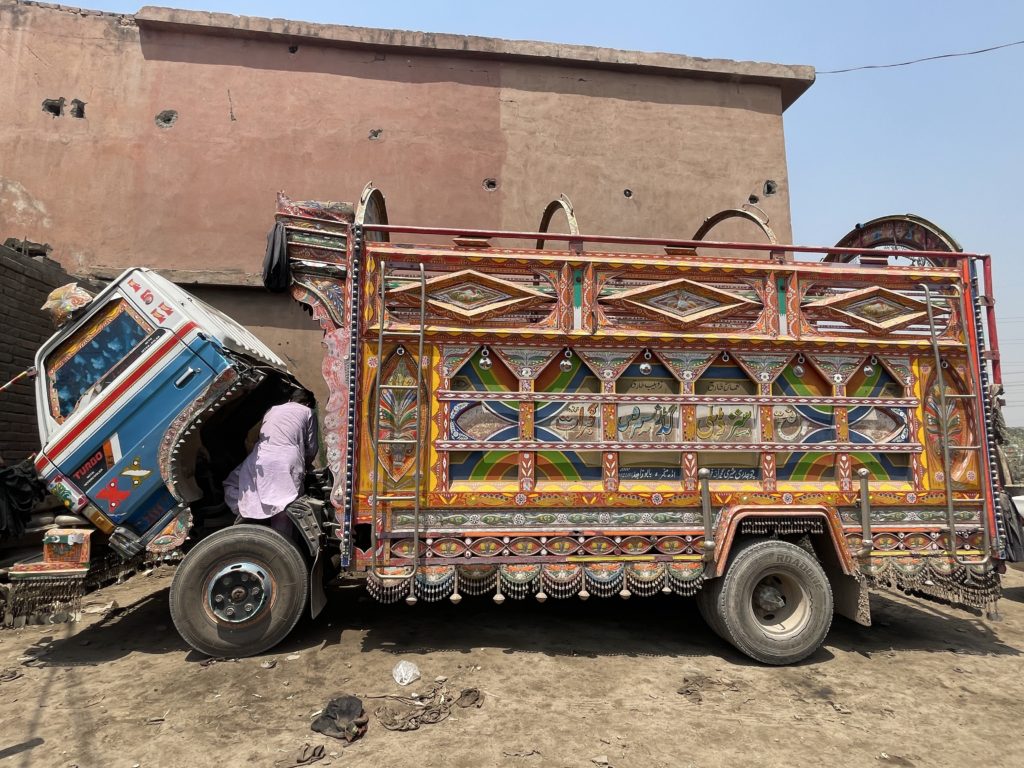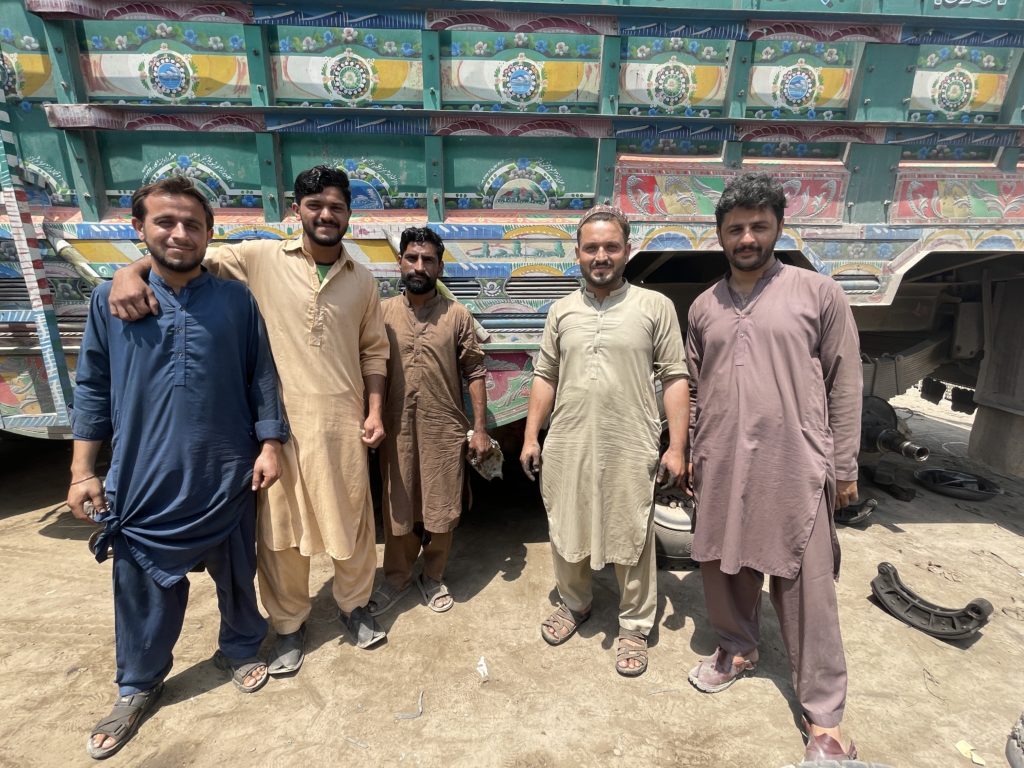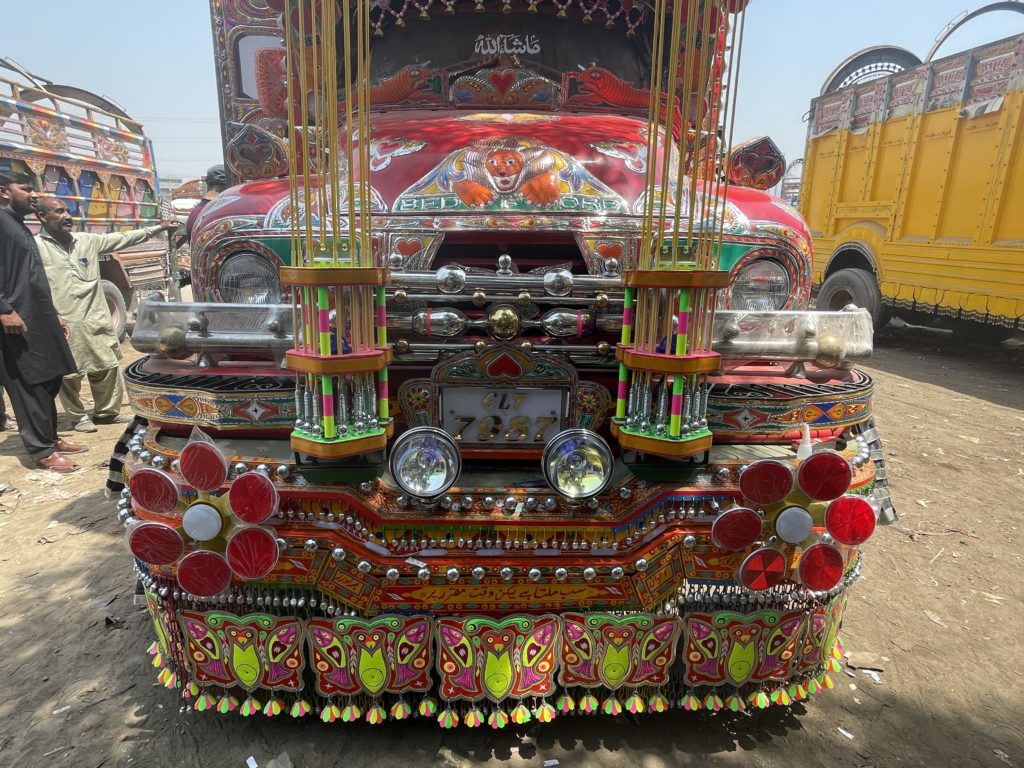Leaving Chitral along the main highway (which was about wide enough for a car and a half) Saaed played chicken with oncoming trucks, vans and ‘mummy daddy’ cars (more on them later). We turned off the main road at Ayun – a mostly muslim village, and home to lots of Afghan refugees, and headed up the Kalash valley road to Kafirstan. Kafir is the word muslims use for pagans or non believers. And the Kalash are a tiny minority of pagan non muslims (c. 4-6,000 of them) who live in three valleys (Rumbor, Bumberet and Birir) near Chitral. No-one knows where the Kalash came from – the best guesses are that they descended from some of Alexander the Greats lost soldiers, alternatively they are thought to be related in some way to Greek civilisation, and the Greek government have invested a lot in protecting Kalash history (including funding the lovely Kalash museum)








Kalash used to be very isolated, but the roads are now largely passable in a 4wd or a hardy station wagon, and Bumberet in particular gets a lot of local tourists – coming to see the famous Kalash festivals – in a society where few women are out and about, seeing women drink wine and dance is quite the drawcard.
We first headed up to Rumbour – the quieter of the two main valleys. The road was classic Northern Pakistan, literally excavated (normally with dynamite) from the side of the hill, and only wide enough for one car with the odd passing point. We were staying in Grom, at the guesthouse run by Saifullah and his family. Yasir runs the guesthouse now (one of the six sons). Kausar took us to visit the temple and a few of the houses, but the locals were not keen to have their photos taken (and we didn’t insist).
Returning to the guest house for tea, Jamil (Saifullah’s youngest son) offered to take us for a walk around the village. As he was related to everybody, everyone was happy to have their photo taken. He even took us for a nice easy hike up river to the pasture lands where every family tends their crops. The villages are piled high on top of each other to preserve valley pasture land – all of which is painstakingly irrigated with a complex system of channels. The houses beautifully constructed of wood and slate with carved wooden terraces. We were offered tea by everyone, and interrogated by most of Jamil’s aunties. Obviously they were bewildered as to why we had no kids. But they were also tickled by hubby’s lack of hair and my short hair – very odd. We were impressed by how many babies they had – four seemed to be the minimum; the quality of their fields – really impressive, and the colour of their dresses. Our two favourite aunties might have partaken of a little too much of the Kalash wine and they were hilariously posing for photos – all of which look a bit skew whiff. The local women look amazing, as they wear these black costumes and every women embroiders their own belt and dress. They all wear a headband with a long tail down the back (even the five year olds) – and they are all gorgeous.

































Back at the guest house, our terrace overlooked the village square, where the kids gathered after school to play, the elder boys and men playing volleyball and the veterans playing a form of pétanque with rocks. Three local girls signalled they wanted to come and see me, so I waved them into the guesthouse garden. The introduced themselves in English, and then pointed at my hair. I thought they were amused at how short it was. They then suggested I sit on the step – and I thought we were just sitting to have a chat. Nope. The three of them set to work on my hair, braiding furiously to make sure I looked like a Kalash woman. They were hilarious. They braided, surveyed, braided again. Then they took all the flowers from the garden and stuck them in my hair. Then I lent them my phone so they could take selfies, of which they took many, giggling and deleting the ones that they didn’t think they looked good in.
We then went and hung out watching the volleyball and the petanque – and the local boys starting doing flips and jumps for Stephane so he would take photos – although pretty impossible to photograph them given how fast they were moving, and they all crowded around him to check out the pictures.












We had a lovely dinner of beef, beans, green beans and potato curry with fresh naan in the garden and had an early night.
Breakfast was a feast of omelette, homemade walnut bread and honey, and lots of coffee. And then we farewelled the family and headed off down the valley to turn right and go up the Bumberet valley. I will confess up front, I didn’t like Bumberet anywhere near as Rumbour, as there were lots of hotels and lots of traffic.
We first visited the Kalash museum which was a stunning building funded by the a greek charity who built the museum and also bought many of the Kalash treasures from Chitral and further afield to return them to the valley. The also buy artefacts from the valleys to ensure they are preserved. Definitely worth a visit.






We then headed up to the graveyard at Karakul. Kalasha were famous for leaving their dead in wooden coffins above ground, a practice that seems to have diminished, but some of the old graveyards are still around. We ran into a big group of ‘mummy daddies’. This is what the Pakistanis call the upper middle class elite. Known for instagramming, not dressing halal (women with uncovered heads), and generally having no manners. Also named as they live on ‘mummy daddy’ money. It is quite hilarious that the locals here like foreigners more than domestic tourists, and the Kalasha get annoyed with so many of the domestic tourists walking into their houses uninvited to take photos. The group of domestic guys had decided to jump the fence and clamber over the coffins to take photos – very ‘mummy daddy’ behaviour. Not impressed, and I was happy when Kausar told them off.
We wandered around Karakul village which was a bit grubby with the upper irrigation channel seeming to be the village loo. I did find a street filled with largely female run Kalasha shops, so I distributed money around in the pursuit of encouraging commerce and have come home with a lovely Kalasha headdress which I will never wear and some jewellery.

















We then wandered up to Brun to look at the statues the Kalasha believe can house their souls, and stopped in to visit a friend of Kausar’s for tea. We decided on a ‘fast’ lunch, as every hotel lunch we try is freshly cooked which means it takes over an hour. So instead we found a small local restaurant with a busy tandoor oven and quite a lot of dirt, and had naan and Loubia (beans).
I really enjoyed Rumbour and think I will likely come back. Apparently there is a trek that you can do from Chitral through the mountains, so I will ask Jamil and Yasir to sort me out a guide at the right point – having a Kalasha will be key as you need to speak their language. Jamil is studying tourism in Chitral, but if he is at home he was a great guide. WhatsApp him on +92 3443857773
Political icons
Politics is a big deal in Pakistan. I reckon our driver and guide spent half the car rides debating Musharraf vs Imran Kahn. What we found fascinating though was how political campaigning had been simplified for anyone illiterate by using symbols on their campaign posters which are liberally on every surface in even the remotest village – a bat for Imran khan, a book for the devout Muslim party, a goat etc. When people go to vote they can mark the symbol on the ballot card without needing to read the name



Meeting a travel superstar
We bumped back along the road to Ayun, and installed ourselves for a lazy afternoon drinking mixed tea on the breezy verandah at the delightful Ayun Fort Inn (also owned by a former royal). In an amusing twist of fate, there were two other guests at our hotel – Jonny Bealby (founder of Wild frontiers) and his lovely wife Anna. Jonny visited Rumbour many years ago on an epic journey and lived with Saifullah for three months before deciding to set up a travel company to bring westerners to the Kalash (the first ever Wild Frontiers trip), and he is en route for another visit. We had a great chat about travel and he shared some of the more complicated parts of the Kalash’s history – including the murder of Saifullah’s brother by merchants and multiple attempts on his life, as Saifullah fought to protect the Kalash’s grazing and crop rights all the way to the highest courts in pakistan (see p19 of this for more details).
Our next stop was Islamabad, and alhamdulillah the plane flew. We had an interesting day at the airport in Chitral wondering if the flight would come – 50% of them get cancelled. We did go – but 90 minutes late. The plane was ful, with half of the passengers showing up just before the flight left – they must wait until they know the flight has left Islamabad. We had been warned the flights were erratic, and the road journey takes at least 10 hours, so we had left spare time in case we had to drive. It was hot and late afternoon when we landed in sweltering Islamabad so we had a lazy afternoon in the Serena Hotel (enjoying the air con and a bath) and had an excellent Lebanese dinner.
Idling in Islamabad
We didn’t have busy plans for Islamabad – our last day of holidays we always like to take it easy and we had a midnight flight home. but we did rouse ourselves to see the main sites. First up the lovely Faisal mosque – for me it was like the Barbican of Mosques with some excellent modernist brutalist details. The mosque was closed outside of prayer time, but we peeked through the windows like the locals.







We then headed to the Hazrat Bari Imam Sarkar shrine just out of town – which is a famous Sufi shrine. They don’t see many tourists, so it took me a while to visit the women’s section as every woman stood up to shake my hand




But the absolute highlight of the day was leaving the groomed and orderly streets of Islamabad and heading to bonkers Rawalpindi to see the truck decorating zone. Owners of trucks in Pakistan take great pride in their vehicles and spend an absolute fortune making them look lovely. If you can afford it, no surface is left unadorned – the cab, the wheels and even the inside loading bay.































Battling the heat, we also wandered around the main Bazaar in Pindi. But by 1pm I was literally having a melt down in the forty degree heat so retreated to the hotel for a lazy afternoon.















That was it – our last day in Pakistan. highly recommend, and we will be back.
Islamabad, 4 June 2022
Additional info
This blog was helpful for anyone wanting to organise their own visit to the Kalash, and this was useful background. Also Jonny’s blog on the Kalash https://www.wildfrontierstravel.com/en_GB/blog/return-to-pakistan-the-birthplace-of-wild-frontiers
Things to bring
- basic guesthouses don’t change the linen – you might want to bring a silk sleeping bag liner
- Coffee isn’t great or always available, I carry Nescafé 2in1 sachets.
- Toilet paper is rare in the loo – we always have spare
- Immodium (the dissolve on your tongue one is the most efficient), Motril (for vomiting) and rehydration tablets (I use Nuun zero)
- Light head scarf (or 3) – the local ladies will be grateful, wear everywhere except Kalash
- Long sleeves and long pants, with shirts covering your bum if you are a lady. I have several loose summer linen ones from M&S. If in doubt always cover to your wrists and ankles and throw a scarf on your head.
Getting around Pakistan
There are lots of different options. I think it is quite easy to come and work your way around on public transport or arrange as you go, provided you have time. However, I didn’t find a single decent guide book.
Public transport? – At my advanced age, I don’t really do public transport except for trains as I like to stop when I want to take photos, and (probably more relevant) I have a very cheap bladder so need to pee all the time. Gone are the days when I want to spend 9 hours on the back of a minibus cramped with locals and chickens and only one pee break. But the transport here is efficient and reliable and really cheap
Group tour? – Lots of good agencies run group tours (untamed borders, wild frontiers)- I am not a fan of those either as like to flex the itinerary and hotels to suit myself. We also realised that most villages don’t have capacity for big groups – so the group tour being run by untamed borders when we were here didn’t stay in Mastuj or Phander as they don’t have guesthouses with more than six rooms. So you may see different things on a group tour and have to stay in bigger towns.
Lazy single tour – I tend to have more money than time these days so we tend to always book private transport – and if somewhere complicated (like Iraq) a guide. Pakistan is super safe and lots of people speak English, but a driver is a good idea if you can afford it. We had lots of fun on our road trips stopping exactly where we wanted for photos. I booked with Kausar and James at untamed borders.
You must be logged in to post a comment.